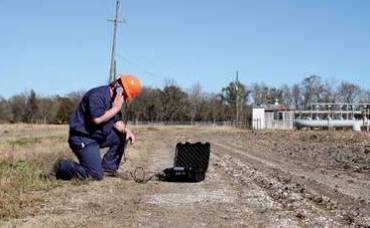What Is Pigging In Oil And Gas Pipelines?
 the term Pigging, in pipeline terminology, refers to an in-line inspection technique in which devices known as pigs are inserted into pipelines to perform a multitude of different cleaning and inspection activities. Pigging was first used in large diameter piping, but with improved technology it can now be conducted on a variety of pipelines sizes without having to stop the flow of liquid or gas through the line.
the term Pigging, in pipeline terminology, refers to an in-line inspection technique in which devices known as pigs are inserted into pipelines to perform a multitude of different cleaning and inspection activities. Pigging was first used in large diameter piping, but with improved technology it can now be conducted on a variety of pipelines sizes without having to stop the flow of liquid or gas through the line.
How Does Pigging Work? Pipeline Pigging Procedure Explained!
A pig is inserted into a pipeline at a valve or pump station that has special configurations of valves and pipes that allow the tool to be loaded into a receiver. As soon as the receiver has been closed and sealed, the pig is then pulled or pushed down the line by either a cable or the pressure of the product flowing through the pipe..
Pigging was historically used only for cleaning pipeline systems, but their uses are diversifying. Pigs were simply placed in a pipeline, and the product flow would push them through. As the pig travels down the pipe it scrapes the sides, removing dirt and debris.
Pigs can be equipped with various nondestructive examination technologies, which scan the pipe they travel through for inspection. There are several different types of smart pigs used in ILI activities, each with its own set of advantages and disadvantages. Depending on their NDE capabilities, some are better at detecting certain types of corrosion in different types of pipes. In recent years, some manufacturers have combined the functions of these separate tools into one and by doing so, a single tool can now be used to detect several different types of damage, resulting in increased efficiency.
What is Intelligent or Smart Pigging
During intelligent pigging, a probe, often called a "smart" pig, is propelled through a pipeline while gathering important data, such as corrosion levels and locations.
The difference between intelligent pigging and traditional pigging is that smart pigs can perform advanced pipeline pigging calculations and inspection activities along the pipe, in addition to cleaning it. A smart pig uses nondestructive inspection techniques such as ultrasonic testing and magnetic flux leakage analysis to identify erosion corrosion, metal loss, pitting, weld anomalies, and hydrogen induced cracking, among other things. Additionally, they can measure the diameter, curvature, bends, and temperature of the pipeline.
The advantages of smart pigging over traditional pipeline inspection methods include:
- Cleaning and inspecting pipelines without shutting down the product flow is made possible
- It allows a pipeline to be inspected completely without having to send inspectors down its entire length
- Additionally, it provides cleaning and inspection services simultaneously, saving both time and money for companies.
Types of Pigging of Pipelines
In order to achieve the best results, choosing the appropriate pipeline pig is critical. Here are some types of pipeline pigs currently in use in the oil and gas industry:
- Utility Pigs - These pigs are used to clean, dewater, and seal gas pipelines. Utility pigs sweep through a gas line's interior, removing debris and semi-solids that obstruct or restrict hydrocarbon flow.
- Mandrel Pigs contain special brushes that remove debris from the internal sections of pipelines.
- Solid Cast Pigs are made of a single piece of steel or polyurethane polymer.
- Foam Pigs are made of polymer foam embedded with solid abrasive materials.
- Spherical Pigs are made from hollow, inflatable polyurethane or neoprene balls.
- Gel Pigs are made up of chemical compounds such as high viscosity gels and rigid polymers.
- Inspection Pigs, or smart pigs, examine the inside of gas pipelines before remediation work is done and there are several electronic components included for various measurements.
- Specialty plugs or pipes are used to seal off complete pipeline sections during remediation activities.
Other Popular Pages:
